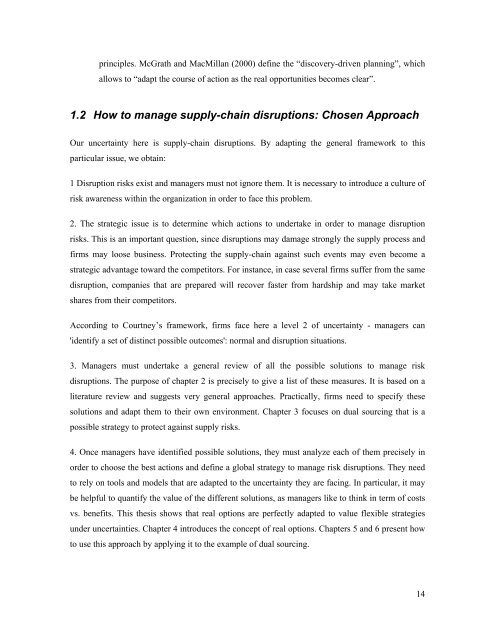Managing Risks of Supply-Chain Disruptions: Dual ... - CiteSeerX
Managing Risks of Supply-Chain Disruptions: Dual ... - CiteSeerX
Managing Risks of Supply-Chain Disruptions: Dual ... - CiteSeerX
Create successful ePaper yourself
Turn your PDF publications into a flip-book with our unique Google optimized e-Paper software.
principles. McGrath and MacMillan (2000) define the “discovery-driven planning”, whichallows to “adapt the course <strong>of</strong> action as the real opportunities becomes clear”.1.2 How to manage supply-chain disruptions: Chosen ApproachOur uncertainty here is supply-chain disruptions. By adapting the general framework to thisparticular issue, we obtain:1 Disruption risks exist and managers must not ignore them. It is necessary to introduce a culture <strong>of</strong>risk awareness within the organization in order to face this problem.2. The strategic issue is to determine which actions to undertake in order to manage disruptionrisks. This is an important question, since disruptions may damage strongly the supply process andfirms may loose business. Protecting the supply-chain against such events may even become astrategic advantage toward the competitors. For instance, in case several firms suffer from the samedisruption, companies that are prepared will recover faster from hardship and may take marketshares from their competitors.According to Courtney’s framework, firms face here a level 2 <strong>of</strong> uncertainty - managers can'identify a set <strong>of</strong> distinct possible outcomes': normal and disruption situations.3. Managers must undertake a general review <strong>of</strong> all the possible solutions to manage riskdisruptions. The purpose <strong>of</strong> chapter 2 is precisely to give a list <strong>of</strong> these measures. It is based on aliterature review and suggests very general approaches. Practically, firms need to specify thesesolutions and adapt them to their own environment. Chapter 3 focuses on dual sourcing that is apossible strategy to protect against supply risks.4. Once managers have identified possible solutions, they must analyze each <strong>of</strong> them precisely inorder to choose the best actions and define a global strategy to manage risk disruptions. They needto rely on tools and models that are adapted to the uncertainty they are facing. In particular, it maybe helpful to quantify the value <strong>of</strong> the different solutions, as managers like to think in term <strong>of</strong> costsvs. benefits. This thesis shows that real options are perfectly adapted to value flexible strategiesunder uncertainties. Chapter 4 introduces the concept <strong>of</strong> real options. Chapters 5 and 6 present howto use this approach by applying it to the example <strong>of</strong> dual sourcing.14
















